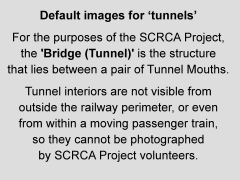A railway tunnel is a long artificial passageway constructed below the ground or through an obstacle such as a hill or large building to create a route for a railway line.
For the purposes of the SCRCA Project, the 'Bridge (Tunnel)' is the hidden structure that lies between a pair of Tunnel Mouths. This distinction has been made because tunnel interiors are not normally visible from outside the railway perimeter, or even from within a moving passenger train (due to the lack of lighting, the speed of the train and the limited angle of view from side windows). 'Tunnels' cannot therefore be 'visited', 'assessed' or photographed by SCRCA Project volunteers. Also, in terms of the management of the Conservation Area, the structural form and physical appearance of 'tunnel' interiors is irrelevant. Finally, listing the component structures separately allows them to be geo-located with a reasonable degree of accuracy. The latter is especially important for the longer tunnels. For example, the Tunnel Mouths for Rise Hill Tunnel are almost two-thirds of a mile apart (1,213 yards / 1,109 metres), while those for Blea Moor Tunnel are more than one and a half miles apart (2,629 yards / 2,404 metres).
For more information about tunnels, please refer to the related article "What are railway tunnels and why are they necessary?".

